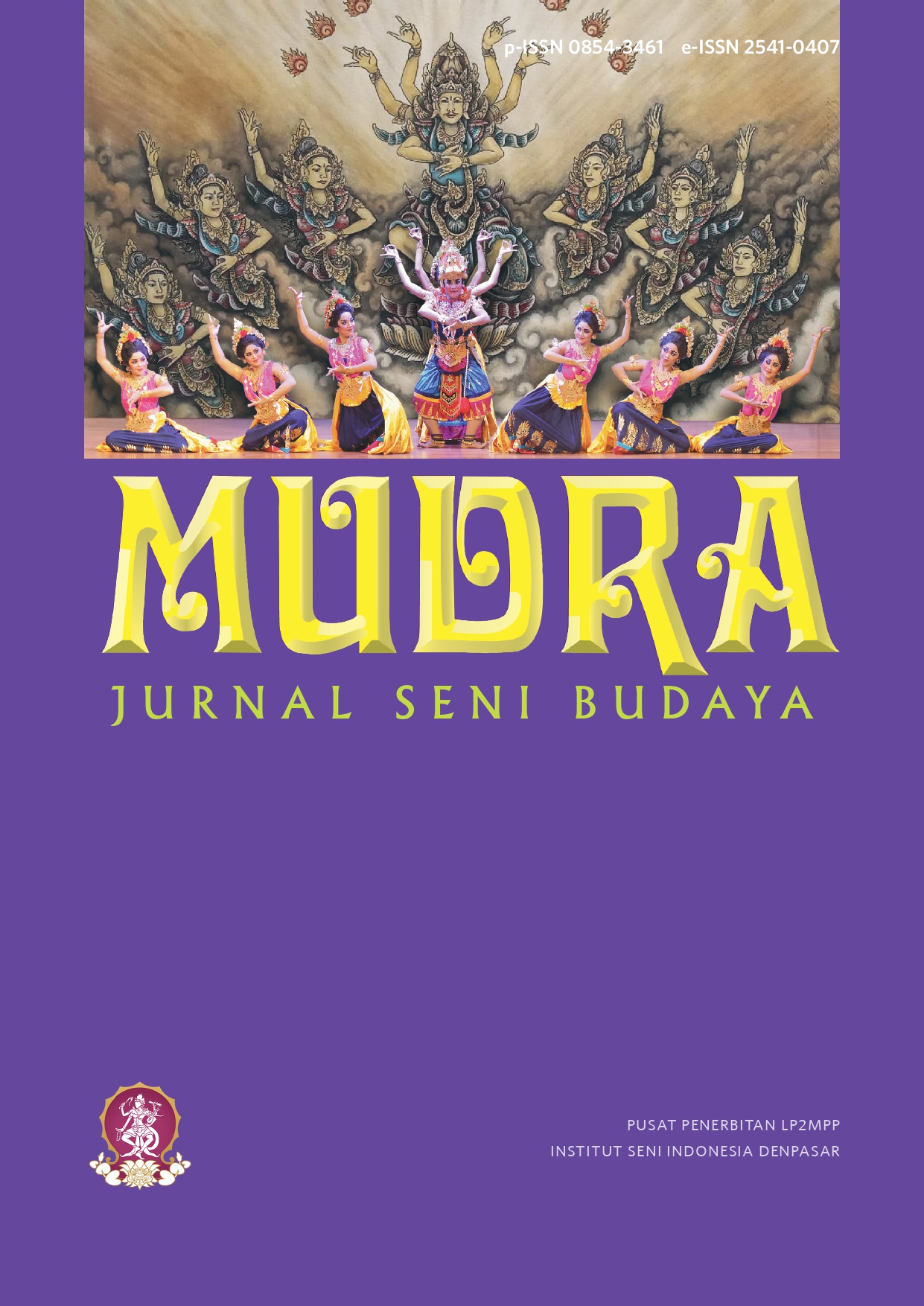Defining Vocal Aesthetic Parameters in Tembang Sunda Cianjuran: A Case Study of the PTSC DAMAS Competition
DOI:
https://doi.org/10.31091/mudra.v40i3.3141Keywords:
Music Assessment, Parameter Aesthetic, PTSC DAMAS, Tembang Sunda Cianjuran, Competition, Traditional SingingAbstract
This study develops a conceptual framework to define a distinguished panembang (vocalist) in Tembang Sunda Cianjuran based on a case study of the PTSC DAMAS competition. Employing a qualitative research design, the study integrates triangulation methods data, techniques, and sources to enhance validity. Data were obtained through in-depth interviews with 12 key informants (including judges, panembang, and cultural experts), field observations, and document analysis. The analytical framework is based on A.A.M. Djelantik's aesthetic theory and uses Miles and Huberman's interactive model for data analysis. The study identifies five core parameters: Bener (accuracy), Merenah (proportionality), Genah (melodiousness), Alus (artistic refinement), and Mulus (flawless integration), each with context-specific indicators. These findings offer a culturally grounded yet methodologically rigorous model for evaluating performance quality in traditional Sundanese vocal arts. The proposed parameters offer a foundational step toward developing a more objective, transparent, and accountable judging system.
Downloads
References
S. Gustina, F. R. Paz, and Z. S. Soeteja, “Representation of Local Styles in Cingcangkeling Performance at the International Choir Festival as a Reflection of Sunda Cultural Identity,” Harmon. J. Arts Res. Educ., vol. 23, no. 1, pp. 91–104, Jun. 2023, doi: 10.15294/harmonia.v23i1.40029.
J.-P. Pérez-Rufí, “Adam Dubin, Dean Vuletic and Antonio Obregón (Eds.). The Eurovision Song Contest as a Cultural Phenomenon. From Concert Halls to the Halls of Academia. Published by Routledge, New York (2023), 275 pp.,” Commun. Soc., pp. 217–219, Apr. 2024, doi: 10.15581/003.37.2.217-219.
L. McCormick, “Higher, Faster, Louder: Representations of the International Music Competition,” Cult. Sociol., vol. 3, no. 1, pp. 5–30, Mar. 2009, doi: 10.1177/1749975508100669.
G. Press-Barnathan and N. Lutz, “The multilevel identity politics of the 2019 Eurovision Song Contest,” Int. Aff., vol. 96, no. 3, pp. 729–748, May 2020, doi: 10.1093/ia/iiaa004.
J. A. Amegashie, “American Idol: Should it Be a Singing Contest or a Popularity Contest?,” SSRN Electron. J., 2007, doi: 10.2139/ssrn.1071243.
S. Cowell, “All Together Now! Publics and Participation in American Idol,” Invis. Cult., Sep. 2003, doi: 10.47761/494a02f6.77ca37f2.
D. Shamoon, “Recreating traditional music in postwar Japan: a prehistory of enka,” Jpn. Forum, vol. 26, no. 1, pp. 113–138, Jan. 2014, doi: 10.1080/09555803.2013.824019.
G. Plaja-Roglans, T. Nuttall, L. Pearson, X. Serra, and M. Miron, “Repertoire-Specific Vocal Pitch Data Generation for Improved Melodic Analysis of Carnatic Music,” Trans. Int. Soc. Music Inf. Retr., vol. 6, no. 1, pp. 13–26, Jun. 2023, doi: 10.5334/tismir.137.
M. Y. Wiradiredja, “PERANAN R. A. A. WIRANATAKUSUMAH V DALAM PENYEBARAN TEMBANG SUNDA CIANJURAN,” Panggung, vol. 22, no. 3, Jul. 2012, doi: 10.26742/panggung.v22i3.77.
A. Budiman, “NEGOTIATING TRADITION AND MODERNITY: THE DIALECTICS OF CONSERVATISM AND PROGRESSIVISM IN TEMBANG SUNDA NYIAR LUANG TINA CIANJURAN,” J. Kaji. Seni, vol. 11, no. 2, pp. 180–194, 2025.
J. Julia, “Pasanggiri Damas: A Strategy To Preserve Tembang Sunda Cianjuran Art in West Java, Indonesia,” Komunitas, vol. 10, no. 1, pp. 44–52, Mar. 2018, doi: 10.15294/komunitas.v10i1.13019.
D. Hendrayana, “Cianjuran Sepi Peminat,” Pikiran Rakyat, Bandung, Indonesia, p. 23, Nov. 12, 2016.
L. Spierdijk and M. Vellekoop, “The structure of bias in peer voting systems: lessons from the Eurovision Song Contest,” Empir. Econ., vol. 36, no. 2, pp. 403–425, May 2009, doi: 10.1007/s00181-008-0202-5.
V. Ginsburgh and J. D. Moreno-Ternero, “The Eurovision Song Contest: voting rules, biases and rationality,” J. Cult. Econ., vol. 47, no. 2, pp. 247–277, Jun. 2023, doi: 10.1007/s10824-022-09456-5.
S. Williams, “Wim Van Zanten. Sundanese Music in the Cianjuran Style: Anthropological and Musicological Aspects of Tembang Sunda. Dordrecht, Netherlands: Foris Publications, 1989. xii, 246 pp., map, tables, figures, photos, musical transcriptions, bibliography, discography, appendices, index. Accompanying audiocassette available from Foris Publications or from the Koninklijk Instituut voor Taal-, Land- en Volkenkunde, P.O. Box 9515, 2300 RA Leiden. Folded insert in English, four pages.,” Yearb. Tradit. Music, vol. 24, pp. 159–160, 1992, doi: 10.2307/768479.
S. Williams and W. V. Zanten, “Sundanese Music in the Cianjuran Style: Anthropological and Musicological Aspects of Tembang Sunda,” Yearb. Tradit. Music, vol. 24, p. 159, 1992, doi: 10.2307/768479.
S. Williams, The urbanization of Tembang Sunda, an aristocratic musical genre of West Java, Indonesia. University of Washington, 1990.
D. Hermawan, Gender dalam tembang Sunda Cianjuran /, Cetakan 1.
E. Rosliani, “Analisis Ornamen pada Lagu Dangdanggula Degung dalam Tembang Sunda Cianjuran,” Panggung, vol. 23, no. 1, Mar. 2013, doi: 10.26742/panggung.v23i1.87.
Y. Wiradiredja, Tembang Sunda Cianjuran di Priangan, 1834-2009: dari seni kalangenan sampai seni pertunjukan. Sunan Ambu Press, 2014. [Online]. Available: https://books.google.co.id/books?id=JxO7uCPyjbEC
E. Sukanda, M. K. Atmadinata, and D. Sulaeman, Riwayat pembentukan dan perkembangan Cianjuran, Edisi kedua. Bandung, Indonesia: Atas kerja sama oleh Disparbud Jabar dengan Yayasan Pancaniti, 2016.
S. Williams, “Competition in the sundaness performing arts of West Java, Indonesia,” Curr. Musicol., no. 63, p. 27, 1997.
A. A. M. Djelantik, Estetika: sebuah pengantar. Masyarakat Seni Pertunjukan Indonesia, 1999. [Online]. Available: https://books.google.co.id/books?id=ZipTNwAACAAJ
W. M. Lim, “What Is Qualitative Research? An Overview and Guidelines,” Australas. Mark. J., vol. 33, no. 2, pp. 199–229, May 2025, doi: 10.1177/14413582241264619.
J. W. Creswell, Research Design: Qualitative, Quantitative, and Mixed Methods Approaches. SAGE Publications, 2014. [Online]. Available: https://books.google.co.id/books?id=4uB76IC_pOQC
M. B. Miles and A. M. Huberman, Qualitative data analysis: an expanded sourcebook, 2nd ed. Thousand Oaks: Sage Publications, 1994.
C.-J. Tsay, “The vision heuristic: Judging music ensembles by sight alone,” Organ. Behav. Hum. Decis. Process., vol. 124, no. 1, pp. 24–33, May 2014, doi: 10.1016/j.obhdp.2013.10.003.
J. W. Davidson and D. Da Costa Coimbra, “Investigating Performance Evaluation by Assessors of Singers in a Music College Setting,” Music. Sci., vol. 5, no. 1, pp. 33–53, Mar. 2001, doi: 10.1177/102986490100500103.
J. Droege, “First impression biases in the performing arts: taste-based discrimination and the value of blind auditioning,” J. Cult. Econ., vol. 46, no. 3, pp. 391–437, Sep. 2022, doi: 10.1007/s10824-021-09428-1.
S. Rustiyanti, F. Djajasudarma, E. Caturwati, and L. Meilinawati, “Estetika Tari Minang dalam Kesenian Randai Analisis Tekstual-Kontekstual,” Panggung, vol. 23, no. 1, Mar. 2013, doi: 10.26742/panggung.v23i1.86.
J. Jamaludin, Anwar Subkiman, and Edwin Widia, “The Meaning of Symbolic Aesthetic of Basic Shapes in Sundanese Culture,” Mudra J. Seni Budaya, vol. 39, no. 1, pp. 69–75, Jan. 2024, doi: 10.31091/mudra.v39i1.2505.
R. Sarinah, “Nembang Nu Hadè,” Manglè, 2006.
R. Sarinah, “Leuwih Hese Mana? Diajar Tembang atawa Nembang?,” Manglè, 2006.
G. Waddell, “Book review: Expressiveness in music performance: Empirical approaches across styles and cultures Oxford. By D. Fabian, R. Timmers, & E. Schubert (Eds.),” Psychol. Music, vol. 43, no. 6, pp. 909–912, Nov. 2015, doi: 10.1177/0305735615577769.
S. Vieillard, M. Roy, and I. Peretz, “Expressiveness in musical emotions,” Psychol. Res., vol. 76, no. 5, pp. 641–653, Sep. 2012, doi: 10.1007/s00426-011-0361-4.
Downloads
Published
How to Cite
Issue
Section
License
Copyright (c) 2025 Arif Budiman, Nanang Jaenudin

This work is licensed under a Creative Commons Attribution-NonCommercial-ShareAlike 4.0 International License.
- Copyright on any open access article in a journal published by Mudra Jurnal Seni Budaya is retained by the author(s).
-
The Creative Commons Attribution License 4.0 formalizes these and other terms and conditions of publishing articles.










